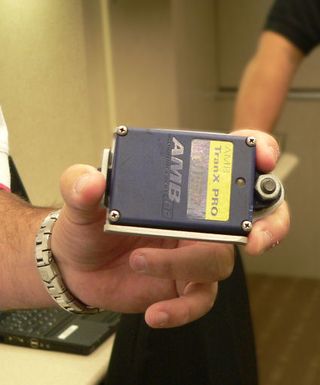How the 'freeze-the-field' rule led to NASCAR's Mobile Technology Center
NASCAR's time machine
We took our tour of the MTC truck at the Indianapolis Motor Speedway, on race day morning for the Allstate 400 at the Brickyard. According to NASCAR senior officials we spoke with, the race that fans still call the "Brickyard 400" has grown to become the #2 most attended single-day sporting event in the country, with close to 300,000 fans in the stands - eclipsing the Kentucky Derby, and now overshadowing even the mighty Daytona 500.

The Indianapolis Motor Speedway, on race day morning, 6 August 2006.
The #1 event, as anyone who lives here in Indianapolis knows, is affectionately referred to as "The Greatest Spectacle in Racing." But for the Indy 500, the wheels are exposed, and the cars are designed to fly apart whenever they strike the new SAFER barrier wall. Although Indy Racing League events are different in many respects, a "freeze-the-field" rule has been in effect for several years, and fans have come to accept it. To implement this rule, a network of sensors is installed in 22 opportune locations all around the Speedway, though not at even intervals - there are certainly more sensors in the front straightaway and the pit area than in the backstretch. When the caution comes out for an IRL race here, the timing and scoring officials seated in the famous pagoda near the grandstands use their software, and make their judgments with regard to how vehicles should line up behind the pace car.
Every major racecourse now has some type of sensor network installed, for servicing either IRL or NASCAR, or both. The IMS had its network installed after an end-of-race incident in 2002, in which Paul Tracy passed race leader Helio Castroneves after the caution was waved. The freeze-of-field rule was already in effect, but Tracy claimed he didn't see the yellow light on the track - even though a video replay showed a yellow light come up on Tracy's steering wheel before the pass even began. Castroneves was declared the winner, but many fans were still left bitter.
NASCAR wants to avoid public feuds between its drivers, in an effort to clean its image and be more presentable to families. But with 42 races in the Nextel Cup circuit alone, NASCAR could no longer afford to lug its servers up and down the elevators of every scoring tower and pagoda on its schedule. Thus the need for the MTC truck, which can pull up alongside the Caterpillar power station and the NBC/TNT mobile production vehicle, and supply the exact same hardware and software for - eventually - every race. (After Steve Worling and his team produce a duplicate vehicle for 2007, it will be equipped with the same hardware and software.)

Steve Worling shows an AMB TranX Pro RFID transponder device, which is mounted behind each race car.
The MTC connects to the IMS' existing fiberoptic network of 22 sensors, called decoders. Each of these decoders serves to project its own crossing line across the racecourse, as it reads the constant pulse of signals sent from RFID transponders mounted on the rear of each vehicle. The transponder itself is two inches long. That's a very important fact, because every NASCAR vehicle is exactly 14 feet long. So the line each decoder represents at its designated position on the racecourse is exactly 14' 2" from its physical location.
Stay on the Cutting Edge
Join the experts who read Tom's Hardware for the inside track on enthusiast PC tech news — and have for over 25 years. We'll send breaking news and in-depth reviews of CPUs, GPUs, AI, maker hardware and more straight to your inbox.
Each decoder is connected to the fiberoptic network by way of a loop, and sometimes officials will call the entire decoder station the "loop." "What it does is record all of those pulses," Garr explained, "and throws out all of them except the strongest one. That's how it calculates the accuracy. It's very accurate, down to about a thousandth of a second."
Current page: NASCAR's time machine
Prev Page We want to race the truck Next Page NASCAR's time machine, ContinuedMost Popular

